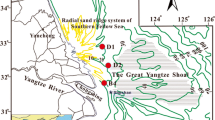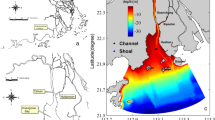Abstract
Results of field experiments using the Virginia Institute of Marine Science' Sea Carousel and tripod system reveal a highly dynamic sediment activity at the Clay Bank site in the York River. At the water-sediment interface, the critical bed shear stress for sediment erosion varied between 0.026 Pa and 0.1 Pa. For the well consolidated sediment below the interface, the critical bed shear stress increased significantly, to more than 0.6 Pa. The seasonal variation of erosion rate for the surficial sediment is significant. For the well consolidated sediment below the surficial sediment, however, the seasonal variation diminished and erosion rate approached a constant. Experimental results from the Carousel deployments imply that the erosion process for quasi-steady tidal flows is always near equilibrium. For this reason, a constant rate erosion model is proposed for the time during tidal acceleration phases. For other times, the erosion rate would be zero. The measured suspended sediment concentration at 10 cm above bed from the VIMS tripod system also Supports this model.
Similar content being viewed by others
References
Amos, C.L., Darborn, G.R., Christian, H.A., Atkinson, A. and Robertson, A.: 1992, In-situ erosion measurements on fine grained sediments from the Bay of Fundy, Mar. Geol. 108, 175-196.
Dade, W.B., Nowell, A.R.M. and Jumar, P.A.: 1992, Predicting erosion resistance of mud, Mar. Geol. 105, 285-297.
Fukuda, M.K. and Lick, W.: 1980, The entrainment of cohesive sediments in freshwater, J. Geophys. Res. 85, 2813-2824.
Grant, J. and Gust, G.: 1987, Prediction of coastal sediment stability from photopigment content of mats of purple sulfur bacteria, Nature 330, 244-246.
Gularte, R.C., Kelly, E.W. and Nacci, V.A.: 1980, Erosion of cohesive sediments as a rate process, Ocean Eng. 7, 539-551.
Parchure, T.M. and Mehta, A.J.: 1985, Erosion of soft cohesive sediment deposits, J. Hydraulic Eng. ASCE 111, 1308-1326.
Risk, M.J., 1980. General intertidal biological processes. In: S.B. McCann (ed.), Sedimentary Processes and Animal-Sediment Relationships in Tidal Environments, G.A.C. Short Course, Vol. 1, pp. 59-94.
Maa, J.P.-Y. and Lee, C.-H.: 1997, Variation of the resuspension coefficients in the lower cheasapeake Bay, J. Coastal Res. 25, 63-74.
Maa, J.P.-Y., Wright, L.D., Lee, C.-H. and Shannon, T.W.: 1993, VIMS Sea Carousal: A field instrument for studying sediment transport, Mar. Geol. 115, 271-287.
Maa, J.P.-Y., Sanford, L. and Halka, J.P.: 1998, Sediment resuspension characteristics in the Baltimore Harbor, Mar. Geol. 146, 137-145.
Owen, M.W.: 1971, The effects of turbulence on floc settling velocities, Proc. 14th Congr. Inst. Assoc. Hydraul. Res., Paper D4, Paris, 1971.
Dellapenna, T.M., Kuehl, S.A. and Schaffner, LC.: 1998, Sea-bed mixing and particle residence times in biologically dominated estuarine systems: a comparison of lower Chesapeake Bay and the York River subestuary, Estuar. Coast. Shelf Sci. 46, 777-795.
Dellapenna, T.M., Kuehl, S.A. and Pitts, L.: 2001, Transient, longitudinal, erosional furrows in the York River subestuary, Chesapeake Bay: Furrow evolution and effects on seabed mixing and sediment transport, Estuaries 24, 215-227.
Kniskern, T.A.: 2001, Spatial and temporal variability of physical and biological mixing in the York River subestuary, M.S. Thesis, School of Marine Science/Virginia Institute of Marine Science, College of William and Mary, 112 pp.
Lin, J.: 2001, A study of the secondary turbidity maximum in the York River estuary, Virginia, Ph. D. Dissertation, School of Marine Science/Virginia Institute of Marine Science, College of William and Mary, 181 pp.
Maa, J. P.-Y.: 1993, VIMS Sea Carousel: Its hydrodynamic characteristics. In: A.J. Mehta (ed.), Nearshore and Estuarine Cohesive Sediment Transport, Coastal and Estuarine Studies, Vol. 42, pp. 265-280, American Geophysical Union, Washington, DC.
Maa, J. P.-Y., Lee, C.-H. and Chen, F.J.: 1995, VIMS Sea Carousel: Bed shear stress measurements, Mar. Geol. 129, 129-136.
Wright, L.D., Schaffner, L.C. and Maa, J.P.-Y.: 1997, Biological mediation of bottom boundary layer processes and sediment suspension in the lower Chesapeake Bay, Mar. Geol. 141, 27-50.
Wright, L.D., Kim, S.-C. and Friedrichs, C.T.: 1999, Across-shelf variations in bed roughness, bed stress and sediment suspension on the Northern California shelf, Mar. Geol. 154, 99-115.
Hayter, E.J.: 1986, Estuarial sediment bed model. In: A.J. Mehta (ed.), Estuarine Cohesive Sediment Dynamics, Lecture Note on Coastal and Estuarine Studies, Chapter XVI, Vol. 14, pp. 215-232, Springer-Verlag, New York.
Author information
Authors and Affiliations
Rights and permissions
About this article
Cite this article
Maa, J.PY., Kim, SC. A Constant Erosion Rate Model for Fine Sediment in the York River, Virginia. Environmental Fluid Mechanics 1, 345–360 (2001). https://doi.org/10.1023/A:1015799926777
Issue Date:
DOI: https://doi.org/10.1023/A:1015799926777




